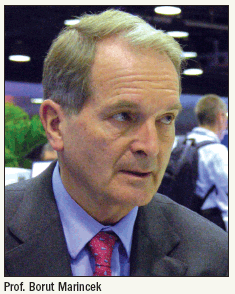First Swiss president wantsECR to scale new heights
Mention Switzerland and most people will think of mountains.Because the country will have its first ever ECR president inMarch, it is no great surprise that the symbol of the congress isone of the world's most famous peaks:the Matterhorn.

Mention Switzerland and most people will think of mountains. Because the country will have its first ever ECR president in March, it is no great surprise that the symbol of the congress is one of the world's most famous peaks: the Matterhorn.
"I want people to remember ECR 2009 as being the summit of science," said ECR president Prof. Borut Marincek. "We need science that is of the highest quality because good science forms the basis of clinical practice. Today's research is tomorrow's practice."
Its name meaning "meadow peak" in German, the Matterhorn is located in the Valais Alps, on the Swiss-Italian border. At around 4480 meters, it is only the 10th highest mountain in Switzerland, but it represents a huge challenge for climbers. Over 500 people have died on the Matterhorn since the first ascent in 1865.
In its pursuit of scientific excellence, ECR 2009 has attracted 5363 abstracts, of which 1684 were accepted. The comparable figures last year were 5264 and 1784. Germany accounts for 248 of ECR 2009's accepted abstracts, followed by Italy (232), U.K. (129), Japan (123), Spain (122), China (99), U.S. (98), Korea (89), France (70), and Austria (53).
Musculoskeletal imaging accounts for 162 accepted abstracts, followed by cardiac (150), neuro (147), abdominal viscera/ solid organs (147), interventional radiology (144), gastrointestinal tract (135), genitourinary (134), chest (128), breast (107), and vascular (94).
The two New Horizons sessions will focus on cell and plaque imaging, while state-of-the-art symposia will address stroke management, lung cancer screening, and the computer and the radiologist. The two professional challenges sessions, to be held on the afternoon of Monday 9 March, will look at imaging of coronary heart disease (perfusion, viability, and function) and maximizing the potential of women.
"We need a critical mass of knowledgeable radiologists to bring in new ideas, and ECR helps to promote diverse discussions among this critical mass," Marincek said. Along with Switzerland, Australia, and New Zealand, Croatia will be a host nation at ECR 2009. Marincek chose this country because he has family connections south of the Alps, his parents coming from Slovenia, and because the opening lecturer, Prof. Hedvig Hricak from New York, is Croatian-born.
Radiologists from Zurich will play a prominent role at ECR 2009. Prof. Anton Valavanis, chair of the Institute of Neuroradiology at Zurich University Hospital, will give the Hans Rudolf Schinz honorary lecture. Schinz was Switzerland's first chair of radiology, and he was president of the Swiss Society of Radiology in the early 20th century. The city has a long tradition of scientific discovery. Wilhelm Conrad Roentgen studied there, and his wife was born in Zurich. Prof. Richard Ernst, who won the Nobel Prize for Chemistry in 1991, has spent his long career in the city.
The department of medical radiology at the Zurich University Hospital is subdivided into four specialty units: general radiology, neuroradiology, nuclear medicine, and radiation oncology. There are also separate units for pediatric and orthopedic radiology.
General radiology is performed at the Institute of Diagnostic Radiology (IDR). Marincek has been its head since 1997 and is currently acting chair of the department of medical radiology.
Around 110,000 imaging procedures are performed annually at the IDR, which employs 15 radiologists, 21 residents, and 48 radiographers and has been filmless since 2003. The number of CT examinations has risen fivefold over the past eight years from around 4000 to more than 19,000, but overall staffing levels have grown by only two residents.
"Our workload has increased significantly, and this means the average radiologist must be much more efficient," he said. "The work has become more demanding and analytical." ECR will take place from 6 to 10 March. More information is available at myESR.org.
GE HealthCare Debuts AI-Powered Cardiac CT Device at ACC Conference
April 1st 2025Featuring enhanced low-dose image quality with motion-free images, the Revolution Vibe CT system reportedly facilitates improved diagnostic clarity for patients with conditions ranging from in-stent restenosis to atrial fibrillation.
The Reading Room Podcast: Current Perspectives on the Updated Appropriate Use Criteria for Brain PET
March 18th 2025In a new podcast, Satoshi Minoshima, M.D., Ph.D., and James Williams, Ph.D., share their insights on the recently updated appropriate use criteria for amyloid PET and tau PET in patients with mild cognitive impairment.